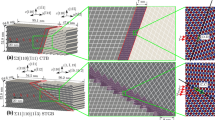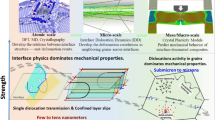Abstract
Using a newly developed embedded-atom-method potential for Mg–Nb, the semi-coherent Mg/Nb interface with the Kurdjumov–Sachs orientation relationship is studied. Atomistic simulations have been carried out to understand the shear strength of the interface, as well as the interaction between lattice glide dislocations and the interface. The interface shear mechanisms are dependent on the shear loading directions, through either interface sliding between Mg and Nb atomic layers or nucleation and gliding of Shockley partial dislocations in between the first two atomic planes in Mg at the interface. The shear strength for the Mg/Nb interface is found to be generally high, in the range of 0.9–1.3 GPa depending on the shear direction. As a consequence, the extents of dislocation core spread into the interface are considerably small, especially when compared to the case of other “weak” interfaces such as the Cu/Nb interface.












Similar content being viewed by others
References
Pollock TM (2010) Weight loss with magnesium alloys. Science 328(5981):986–987. doi:10.1126/science.1182848
Ardeljan M, Beyerlein IJ, Knezevic M (2014) A dislocation density based crystal plasticity finite element model: application to a two-phase polycrystalline HCP/BCC composites. J Mech Phys Solids 66:16–31. doi:10.1016/j.jmps.2014.01.006
Ardeljan M, Knezevic M, Nizolek T, Beyerlein IJ, Mara NA, Pollock TM (2015) A study of microstructure-driven strain localizations in two-phase polycrystalline HCP/BCC composites using a multi-scale model. Int J Plast 74:35–57. doi:10.1016/j.ijplas.2015.06.003
Knezevic M, Nizolek T, Ardeljan M, Beyerlein IJ, Mara NA, Pollock TM (2014) Texture evolution in two-phase Zr/Nb lamellar composites during accumulative roll bonding. Int J Plast 57:16–28. doi:10.1016/j.ijplas.2014.01.008
Junkaew A, Ham B, Zhang X, Talapatra A, Arróyave R (2013) Stabilization of bcc Mg in thin films at ambient pressure: experimental evidence and ab initio calculations. Mater Res Lett 1(3):161–167
Ham B, Zhang X (2011) High strength Mg/Nb nanolayer composites. Mater Sci Eng A Struct 528(4–5):2028–2033. doi:10.1016/j.msea.2010.10.101
Kumar A, Beyerlein IJ, Wang J (2014) First-principles study of the structure of Mg/Nb multilayers. Appl Phys Lett 105(7):071602
Pathak S, Velisavljevic N, Baldwin JK, Jain M, Zheng S, Mara NA, Beyerlein IJ (2017) Strong, ductile, and thermally stable bcc-Mg Nanolaminates. Sci Rep Uk 7(1):8264. doi:10.1038/s41598-017-08302-5
Chen Y Unpublished
Wang J, Hoagland RG, Hirth JP, Misra A (2008) Atomistic modeling of the interaction of glide dislocations with “weak” interfaces. Acta Mater 56(19):5685–5693. doi:10.1016/j.actamat.2008.07.041
Daw MS, Baskes MI (1984) Embedded-atom method—derivation and application to impurities, surfaces, and other defects in metals. Phys Rev B 29(12):6443–6453. doi:10.1103/Physrevb.29.6443
Liu XY, Adams JB, Ercolessi F, Moriarty JA (1996) EAM potential for magnesium from quantum mechanical forces. Model Simul Mater Sci 4(3):293–303
Ackland GJ, Thetford R (1987) An improved N-body semiempirical model for body-centered cubic transition-metals. Philos Mag A 56(1):15–30
Zhang RF, Wang J, Beyerlein IJ, Germann TC (2011) Twinning in bcc metals under shock loading: a challenge to empirical potentials. Philos Mag Lett 91(12):731–740. doi:10.1080/09500839.2011.615348
Zhang RF, Germann TC, Liu XY, Wang J, Beyerlein IJ (2014) Layer size effect on the shock compression behavior of fcc–bcc nanolaminates. Acta Mater 79:74–83. doi:10.1016/j.actamat.2014.07.016
Zhang L, Martinez E, Caro A, Liu X-Y, Demkowicz MJ (2013) Liquid-phase thermodynamics and structures in the Cu–Nb binary system. Model Simul Mater Sci 21(2):025005
Demkowicz MJ, Hoagland RG (2009) Simulations of Collision Cascades in Cu–Nb Layered Composites Using an Eam Interatomic Potential. Int J Appl Mech 1(3):421–442
Liu XY, Hoagland RG, Wang J, Germann TC, Misra A (2010) The influence of dilute heats of mixing on the atomic structures, defect energetics and mechanical properties of fcc–bcc interfaces. Acta Mater 58(13):4549–4557. doi:10.1016/j.actamat.2010.05.008
Liu XY, Hoagland RG, Demkowicz MJ, Nastasi M, Misra A (2012) The influence of lattice misfit on the atomic structures and defect energetics of face centered cubic-body centered cubic interfaces. J Eng Mater T Asme 134(2):021012
Wei QM, Liu XY, Misra A (2011) Observation of continuous and reversible bcc-fcc phase transformation in Ag/V multilayers. Appl Phys Lett 98(11):111907
Chen Y, Shao S, Liu XY, Yadav SK, Li N, Mara N, Wang J (2017) Misfit dislocation patterns of Mg–Nb interfaces. Acta Mater 126:552–563. doi:10.1016/j.actamat.2016.12.041
Wang J, Hoagland R, Liu X, Misra A (2011) The influence of interface shear strength on the glide dislocation–interface interactions. Acta Mater 59(8):3164–3173
Barnett DM, Lothe J (1974) An image force theorem for dislocations in anisotropic bicrystals. J Phys F Met Phys 4(10):1618
Wang J, Hoagland R, Hirth J, Misra A (2008) Atomistic simulations of the shear strength and sliding mechanisms of copper–niobium interfaces. Acta Mater 56(13):3109–3119
Pilania G, Thijsse BJ, Hoagland RG, Lazic I, Valone SM, Liu XY (2014) Revisiting the Al/Al2O3 interface: coherent interfaces and misfit accommodation. Sci Rep Uk 4:4485
Hirth J, Pond R, Hoagland R, Liu X-Y, Wang J (2013) Interface defects, reference spaces and the Frank-Bilby equation. Prog Mater Sci 58(5):749–823
Li J (2003) AtomEye: an efficient atomistic configuration viewer. Model Simul Mater Sci 11(2):173–177
Fan HD, El-Awady JA (2015) Molecular dynamics simulations of orientation effects during tension, compression, and bending deformations of magnesium nanocrystals. J Appl Mech T Asme 82(10):101006
Acknowledgements
This work was supported by the US Department of Energy, Office of Science, Office of Basic Energy Sciences. The authors acknowledge helpful discussions with Richard G. Hoagland at LANL.
Author information
Authors and Affiliations
Corresponding author
Rights and permissions
About this article
Cite this article
Yadav, S.K., Shao, S., Chen, Y. et al. Atomistic modeling of Mg/Nb interfaces: shear strength and interaction with lattice glide dislocations. J Mater Sci 53, 5733–5744 (2018). https://doi.org/10.1007/s10853-017-1703-4
Received:
Accepted:
Published:
Issue Date:
DOI: https://doi.org/10.1007/s10853-017-1703-4




